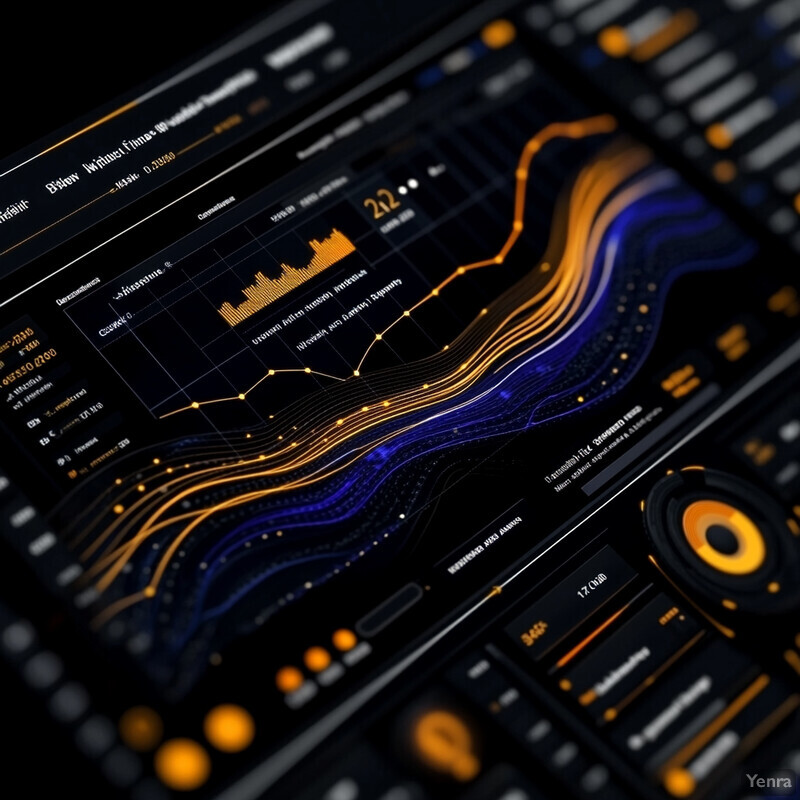1. Automated Data Extraction and Classification
AI-driven tools are revolutionizing the way companies gather and organize tax-relevant data. By leveraging technologies like optical character recognition (OCR) and machine learning, these systems can rapidly scan and classify vast volumes of financial documents (invoices, receipts, ledgers) with minimal human input. This automation not only speeds up data collection but also significantly reduces human error in tax preparation. High-quality data can be extracted and categorized in seconds, ensuring that downstream tax calculations and filings are based on accurate, well-organized information. Overall, AI-based data extraction frees tax professionals from tedious data-entry tasks so they can focus on higher-level analysis and planning.

AI-based data extraction has demonstrated dramatic improvements in both speed and accuracy over manual processes. For example, one study of an AI invoice-processing system showed it achieved about 97–98% accuracy in key field extraction, compared to roughly 85% accuracy under traditional methods. The same system could handle on the order of 150 documents per minute, whereas manual processing might take 15 minutes per document, representing an almost 98% reduction in processing time. These gains translate into fewer transcription errors on tax forms and faster reconciliation of records. In practice, early adopters have seen error rates on tax data drop from around 15% to near 2% after implementing AI validation checks. It’s no surprise that tax departments prioritize this technology – in a recent industry survey, three-quarters of corporate tax teams reported that adopting AI to automate data handling was a top goal for improving efficiency. The result is a more streamlined tax preparation process with reliable data and reduced risk of compliance mistakes from data entry errors.
2. Real-Time Regulatory Tracking
AI enables corporate tax teams to keep pace with constantly changing tax laws and regulations in real time. Machine learning models can continuously monitor government websites, legislative updates, and news sources to detect new tax rules or amendments as they emerge. By automating this regulatory watch, companies are alerted immediately to relevant changes – for instance, a new tax rate, compliance requirement, or court ruling – rather than discovering them after the fact. This proactive tracking ensures that tax planning and compliance measures are always up-to-date with the latest legal landscape. In essence, AI serves as an ever-vigilant “eye” on the tax regulatory environment, helping businesses avoid compliance gaps and capitalize quickly on new incentives or relief measures.

Tax regulations evolve frequently at both domestic and international levels, and AI tools are increasingly used to automate the tracking of these changes. In practice, an AI system can ingest updates from legislatures and tax authorities around the world 24/7, flagging any change that might affect the company’s operations. Corporate tax departments report that staying abreast of tax law changes is among their very highest priorities – one recent survey found it was a close second only to efficiency gains as a top concern. AI addresses this concern by parsing through the deluge of updates and highlighting what’s important. For example, if a major new tax law is passed or guidance is issued, the AI might send an alert with a summary of the change and an analysis of its implications for the company. This means tax teams can respond immediately – updating compliance checklists, adjusting tax strategies, or informing leadership – rather than scrambling after an unrecognized change has taken effect. By using real-time regulatory tracking, companies significantly reduce the risk of falling out of compliance due to overlooked rule changes and can even proactively adjust to new laws ahead of deadlines.
3. Predictive Analytics for Tax Liability Forecasting
Advanced analytics are giving companies a forward-looking view of their tax obligations. By analyzing historical financial data, current performance, and known tax rules, AI-driven models can forecast future tax liabilities with a high degree of precision. These predictive insights allow businesses to anticipate their tax bills well before they are due and to manage cash flow accordingly. For example, companies can use AI forecasts to determine quarterly estimated payments and avoid underpayment penalties or surprise shortfalls. Furthermore, predictive modeling helps in strategic decision-making – such as timing of income, deferring expenses, or accelerating deductions – by showing the tax impact of various scenarios. In short, AI-based forecasting transforms tax planning from a reactive exercise at year-end to a proactive, data-driven process throughout the year.

Companies are required to pre-pay corporate taxes (often in quarterly installments) based on expected income, and inaccuracies in these forecasts can be costly – U.S. corporations paid over $199 million in penalties in 2020 for underestimating their tax due. AI is helping to dramatically improve the accuracy of such forecasts. In a recent study, machine learning models (including neural networks and decision trees) were trained on decades of corporate financial data and demonstrated robust accuracy in predicting quarterly tax payments. These models performed well even during volatile periods (such as the COVID-19 pandemic), outperforming simpler forecasting methods. By deploying similar predictive analytics, a company can minimize over- or under-paying its estimated taxes – avoiding both unnecessary interest costs from overpayment and penalty fees from underpayment. The use of AI for tax forecasting also provides management with clearer visibility: for instance, if the model projects a higher tax liability next year due to rising profits, the firm can set aside reserves or implement tax-saving measures now. Essentially, data-driven tax liability forecasts allow businesses to stay one step ahead, ensuring there are no big surprises when tax time comes around.
4. Enhanced Transfer Pricing Analysis
Transfer pricing – the pricing of transactions between related companies in different tax jurisdictions – is notoriously complex, and AI is helping to navigate this challenge. By quickly analyzing large datasets of comparable transactions and economic indicators, AI systems support tax professionals in setting and reviewing transfer prices that reflect market rates. These tools can identify anomalies or inconsistencies in a company’s intercompany pricing that might raise red flags to regulators, allowing corrections before they become an issue. AI can also incorporate a wide range of data (industry trends, profitability ratios, etc.) to suggest appropriate profit allocations among subsidiaries. Overall, AI augments human expertise in transfer pricing by providing data-driven insights, reducing reliance on purely manual benchmarking. This leads to transfer pricing strategies that are both compliant with diverse international rules and aligned with the company’s business objectives. Importantly, while AI improves efficiency and consistency in analysis, tax experts still provide critical judgment for final decisions, especially in unique or highly strategic transactions.

The IRS and other tax authorities have identified transfer pricing as a high-risk area for tax avoidance, and they are increasingly turning to AI – a recent U.S. Government Accountability Office report noted that AI could help the IRS better detect complex transfer pricing issues as part of closing an estimated $700 billion annual tax gap. On the corporate side, AI tools are being used to fortify transfer pricing compliance and strategy. For example, AI-driven algorithms can rapidly sift through thousands of comparable transactions and economic data points to ensure a company’s intercompany prices are in line with market conditions. This assists in preparing transfer pricing documentation by providing solid evidence that prices charged between affiliates (for goods, services, royalties, etc.) are arm’s-length. AI can also continuously monitor changes in each country’s regulations or economic environment and flag when a company’s existing transfer pricing arrangements might need adjustment. Moreover, AI’s pattern-recognition capabilities help pinpoint transactions or entities that deviate from expected profit ranges, alerting tax managers to investigate further. By leveraging such insights, companies can proactively adjust their transfer pricing models – for instance, modifying fee arrangements or profit splits – before those practices draw scrutiny from auditors. In sum, AI enhances both the defensive aspect of transfer pricing (managing audit risk) and the offensive aspect (strategically allocating profits in a compliant manner).
5. Sophisticated Tax Scenarios and What-If Modeling
AI-powered simulation tools allow tax departments to perform advanced “what-if” analyses with ease. Rather than manually crunching numbers in spreadsheets, tax professionals can input various hypothetical scenarios into an AI model – such as changes in corporate structure, entering a new market, shifts in revenue or expenses – and quickly see the projected tax outcomes. This capability is invaluable for strategic planning. It enables companies to evaluate the tax implications of major decisions before they are executed: for instance, comparing the tax impact of expanding via a subsidiary versus a branch, or the effects of an interest rate change on deductible expenses. AI models consider a multitude of variables (different tax rates, foreign exchange, timing of transactions, etc.) simultaneously, providing a comprehensive view of each scenario’s outcome. With rapid scenario modeling, companies can choose courses of action that optimize after-tax results and avoid unintended consequences. Essentially, AI brings a new level of foresight to corporate tax planning by making scenario analysis faster, more accurate, and more accessible.

Early adopters of AI-driven scenario planning have reported that it enables more nuanced and data-driven decision-making. Sophisticated tax teams are already experimenting with AI to reveal higher-order strategic insights that go beyond basic spreadsheet modeling. For example, an AI tool can simulate the tax effects of shifting a manufacturing operation to a different country – incorporating not just the change in tax rate, but also potential impacts on transfer pricing, customs duties, and available tax incentives in the new location. By running dozens of such scenarios in minutes, companies can identify an optimal strategy (e.g. which location or structure yields the lowest effective tax rate over five years). In one academic study examining corporate behavior, firms that invested in AI showed significantly greater tax efficiency than their peers, suggesting that AI-assisted planning translated into tangible tax savings. These companies managed to integrate tax planning more tightly with operational decisions, thereby reducing reliance on aggressive tax maneuvers and focusing on sustainable strategies. In practice, this might mean finding the ideal timing for intercompany dividends, the best financing mix (debt vs. equity) for new projects, or the projected tax benefit of accelerated depreciation under different economic conditions – all analyzed quickly through AI scenario models. By comparing outcomes, tax leaders can confidently advise on the course that balances business goals with tax minimization, backed by hard data from scenario simulations.
6. Dynamic Tax Compliance Monitoring
AI enables continuous, automated monitoring of transactions and tax filings to ensure compliance issues are caught and addressed in real time. Traditionally, companies might perform periodic reviews or audits of their tax data – for example, checking compliance at quarter-end or year-end. Now, AI-driven systems can constantly scan a company’s financial transactions and accounts as they occur, looking for anomalies or potential compliance risks (such as transactions that don’t have proper tax codes, or sudden fluctuations in tax-sensitive accounts). This “always-on” monitoring means errors or omissions can be flagged immediately, rather than months later when corrections are more difficult. It also helps companies maintain ongoing compliance across multiple jurisdictions by automatically checking that each transaction adheres to the relevant tax rules (e.g., correct VAT rate applied, proper documentation present). Dynamic monitoring significantly reduces the chance of cumulative errors and can generate alerts or even corrective suggestions (like accruing additional tax) well before filings are due. Ultimately, AI’s continuous oversight gives management confidence that their tax compliance status is up-to-date at any given moment, with a greatly reduced risk of surprises during audits.

Companies are beginning to mirror tax authorities in using AI to watch for compliance red flags in real time. For instance, some tax authorities require transaction-level reporting – in Colombia, electronic invoices are now compared against VAT returns on an ongoing basis to ensure consistency, and AI tools help companies reconcile those data points automatically. Internally, a corporation might employ an AI system to cross-check every recorded sale, purchase, or payroll entry against tax rules: if an entry falls outside expected parameters (say, a use tax not applied when it should be), the system will immediately notify the tax team for review. Regulatory bodies are certainly upping the game – the IRS has developed AI models to identify and prioritize “high-risk” tax returns for audit, particularly focusing on complex filings like those of large partnerships. These models analyze patterns in the data to predict which returns are likely non-compliant, thereby improving audit hit rates. In response, forward-thinking companies are deploying similar analytics on their own data, effectively performing a self-audit on 100% of transactions. If, for example, an AI compliance monitor in a company detects that certain intercompany charges look anomalous compared to transfer pricing policies, it will flag them for correction or additional documentation. By catching such issues proactively, companies can remediate them before any regulatory audit occurs. The outcome is fewer penalties and restatements – in other words, a stronger compliance posture – thanks to AI’s ability to scrutinize vast amounts of tax data continuously and consistently.
7. Natural Language Processing for Tax Code Interpretation
AI’s natural language processing (NLP) capabilities are empowering tax professionals to navigate complex tax laws and regulations more efficiently. Instead of poring over dense tax code sections and rulings, practitioners can now use AI language models (like advanced chatbots or legal AI assistants) to interpret and even explain tax rules in plain language. These models, trained on vast corpora of legal texts and guidance, can answer specific questions (e.g., “What expenses qualify for the R&D credit under Section X?”) by referencing the relevant provisions. They can also summarize lengthy legislation or regulatory guidance into digestible bullet points, saving countless hours of manual research. In effect, NLP tools act like intelligent research assistants: a user can input a tax query or paste a snippet of code language, and the AI will produce an analysis or summary, often with surprising accuracy. This is especially valuable given the volume and complexity of tax laws – NLP helps ensure nothing critical is overlooked and that interpretations are consistent. While human judgment is still essential (especially for nuanced or unprecedented issues), AI significantly accelerates the legal research and interpretation phase of tax work. It makes the vast body of tax knowledge more accessible, even to non-specialists, and helps organizations apply rules correctly.

Recent breakthroughs in large language models have shown that AI can indeed interpret tax law scenarios with a level of competence approaching that of tax experts in certain contexts. In a public demonstration, OpenAI’s GPT-4 was given several U.S. tax code sections and hypothetical taxpayer data; it successfully analyzed the materials and correctly calculated the tax outcomes for the scenario – leading its developers to note that GPT-4 can essentially “do taxes,” at least for those controlled examples. Academic research confirms these capabilities while also highlighting limitations. For instance, one study tested AI models on complex tax questions derived from real legal cases and statutes. The best-performing model (a state-of-the-art commercial AI) achieved about 75% accuracy on a challenging set of tax law questions that required applying statutes to facts. This is a notable result, though it also means there is room for improvement on the trickiest issues. The AI tended to excel at straightforward applications of rules and struggled more with highly context-specific judgments – a pattern similar to junior tax professionals who are still learning. Importantly, when AI models are augmented with retrieval tools (feeding them relevant sections of code or regulations as needed), their performance improves, indicating that providing up-to-date source material helps ensure correct interpretations. In practice, companies are beginning to integrate such NLP tools into their workflows: a tax analyst can ask an AI assistant to “summarize the latest IRS guidance on topic Y” or “find the definition of ‘dependent’ in Section 152,” and get near-instant answers. This dramatically cuts research time and helps standardize interpretations across the tax team, as everyone can quickly cross-check their understanding using the same AI resource. As these tools continue to evolve – under careful supervision – they are poised to become an indispensable part of the tax professional’s toolkit, handling the heavy lifting of reading and parsing tax law so humans can focus on nuanced application and planning.
8. Risk Scoring and Audit Readiness
AI is changing how companies assess and manage tax risk, making the process more data-driven and preemptive. Using machine learning, companies can assign risk scores to various tax positions or entries on their tax returns, indicating the likelihood that each item could be questioned by auditors or result in an adjustment. These scores are derived by analyzing patterns from past audits, known aggressive positions, or discrepancies – essentially encapsulating expert knowledge and audit experience into an algorithm. With this information, tax teams can prioritize which areas need the most thorough documentation or perhaps a more conservative approach. AI can also simulate an auditor’s perspective, flagging transactions or filings that deviate from industry norms or IRS benchmarks (for example, an unusually low effective tax rate relative to peers might get flagged). By identifying red flags internally, companies become audit-ready: they can fix problems or prepare detailed justifications before the tax authority comes knocking. This AI-enhanced risk management leads to better allocation of resources (focusing compliance efforts where risk is highest) and ultimately fewer surprises in the event of a tax audit.

Tax authorities themselves are leveraging AI for risk assessment, and companies are following suit to avoid falling behind. The IRS, for instance, now uses AI-based models to help triage and select tax returns for audit – these models analyze historical data to spot patterns that correlate with underreporting or errors, enabling the IRS to concentrate on the returns most likely to have issues. In the realm of large partnerships and complex corporate filings, the IRS has deployed AI tools to identify high-risk areas (and the agency has started audits of dozens of large entities flagged by these algorithms). This trend signals to companies that any potential weak point in their tax filings might be identified by advanced analytics. Consequently, many corporate tax departments are implementing their own AI-driven risk scoring systems. For example, an AI might analyze a company’s tax return and highlight that the transfer pricing outcome for a certain subsidiary appears aggressive compared to typical profit ratios – essentially predicting that an auditor would likely probe that issue. Armed with that knowledge, the company can gather necessary evidence or adjust the pricing to mitigate the risk. Broadly, the use of AI in risk management is rapidly becoming standard practice: about 80% of compliance and risk management professionals globally expect widespread adoption of AI in their field within the next few years, reflecting a recognition that AI can sift through vast financial data to find risks far more efficiently than traditional methods. By embracing these tools, companies transform their approach to audit readiness from reactive to proactive – identifying and strengthening any vulnerable tax positions well before regulators do.
9. Automated Tax Return Preparation
AI is streamlining the labor-intensive process of assembling corporate tax returns. Instead of manually gathering data from various accounting systems and populating tax forms line by line, companies are deploying AI-driven software that can automate the tax return preparation workflow. These systems pull transactional data directly from enterprise resource planning (ERP) and financial reporting systems, classify it according to tax return requirements, and even make preliminary calculations for each schedule. The result is a draft tax return that is largely completed by the software, which tax professionals then review and adjust as needed. Automation dramatically reduces the time needed to prepare returns and lowers the risk of human errors in transcribing numbers or selecting forms. Additionally, modern tools often incorporate AI assistants or chatbots that guide users through complex sections by answering questions (for example, about qualifications for certain deductions or credits). All of this means that corporate tax filings – which used to consume enormous staff hours especially near deadlines – can be generated much faster, allowing more time for analysis, review, and strategic tax planning.

The integration of AI into tax preparation is already happening in practice and yielding significant efficiency gains. A prominent example is H&R Block’s partnership with OpenAI announced in late 2023, where a “ChatGPT”-powered assistant was deployed to help the company’s tax professionals prepare returns more quickly and accurately. These generative AI tools can instantly answer complex tax questions for preparers and double-check entries against tax law, acting as a real-time support system during return filing. Automated tax preparation software can also map data from financial records to the correct tax return fields without manual intervention – for instance, matching each income or expense item to the appropriate line on a tax form, which historically was a painstaking task. According to industry reports, such AI-driven approaches have the potential to cut the time spent on tax compliance work by well over half. One analysis found that using AI agents to handle routine Q&A and data entry during filing could reduce tax filing time by up to 60% for businesses. Moreover, these systems maintain consistency; they won’t overlook a schedule or miscalculate a total the way a rushed human might. Of course, human oversight remains crucial – especially for nuanced tax positions – but AI’s ability to automate the bulk of preparation means the role of the tax professional shifts toward reviewing and handling exceptions. Companies that have adopted automated return prep report faster closes and filing cycles, with some noting that they’ve been able to reallocate staff to more value-added activities (like tax planning or controversy defense) during the busy season, rather than pure number crunching.
10. Hyper-Personalized Tax Optimization Strategies
AI empowers companies to tailor tax planning strategies to the unique circumstances of different business units, transactions, or client profiles, rather than relying on one-size-fits-all approaches. By analyzing detailed data – such as each division’s revenues, expenses, asset base, and the specific tax rules applicable to its operations – AI can identify bespoke tax optimization opportunities for each segment of the business. This might include suggesting entity-specific tax credits or incentives, optimal methods of depreciation, or timing of income and deductions to minimize tax impact. Essentially, AI combs through the fine-grained data and tax parameters to find the best possible tax outcome for every scenario or sub-entity. These strategies can then be aggregated to improve the company’s overall tax efficiency. The result is a highly customized tax plan that takes into account the nuances of every part of the organization – something that would be exceedingly difficult and time-consuming to do manually. Moreover, these AI recommendations update dynamically with changing business conditions or tax laws, ensuring that the tax strategy remains optimized continuously. This level of personalization maximizes legitimate tax benefits while maintaining compliance, and can give companies a competitive edge by not leaving any tax savings “on the table.”

Recent research suggests that companies leveraging AI in their decision-making are indeed achieving more effective tax outcomes. A 2025 study of U.S. firms found that those investing in AI technology saw improved tax efficiency, reflected in lower effective tax rates and reduced need for aggressive tax maneuvers, compared to companies that had not adopted AI tools. In practice, AI-driven tax optimization might look like this: the AI reviews transactions of each subsidiary and recognizes, for example, that one manufacturing unit qualifies for a special R&D credit in its jurisdiction, while another unit could benefit from a different incentive (such as green energy credits) based on its expenses. It then alerts the tax team to take advantage of these breaks, ensuring each unit’s tax strategy is individually optimized. Another scenario is AI identifying that a particular business segment consistently experiences losses that could be utilized better – perhaps by triggering a change in transfer pricing or group financing structure – to ensure those losses yield tax benefits (like refunds or offsets) at the group level. Importantly, AI doesn’t just find opportunities; it also guards against undue risk by noting where the company’s tax positions deviate significantly from industry benchmarks. Companies that use AI in this way report that they can achieve tax savings without pushing into overly aggressive territory, essentially “doing more with less” risk. In one survey, 83% of tax leaders said that greater use of automation and AI is crucial to improving the effectiveness of their tax planning efforts, underscoring a broad recognition that hyper-personalized, data-driven strategies are the future of tax optimization. By continuously iterating these strategies with AI – as new data comes in and laws change – organizations keep their tax posture finely tuned for both compliance and efficiency year after year.
11. Identification of Tax Incentives and Credits
AI systems can rapidly identify and help companies claim the myriad of tax incentives, credits, and exemptions for which they are eligible. This is a significant development because governments at all levels (local, national, international) offer numerous tax incentives – for activities like research and development, renewable energy investments, job creation, etc. – but it’s often challenging for businesses to keep track of them or determine eligibility. AI tools address this by continuously scanning legislation, tax credit databases, and government programs worldwide, then matching the criteria to the company’s activities and profile. In essence, the AI can say, “Here’s a tax credit you qualify for, and here’s the documentation needed,” even for incentives the company wasn’t aware of. By doing so, businesses can maximize their tax savings through credits and incentives that might otherwise go unutilized. This capability is especially useful for large companies operating across multiple jurisdictions, where keeping up with every new incentive (and the sometimes complex application process) would be a full-time job on its own. AI ensures that opportunities for tax reduction – like credits, rebates, and accelerated deductions – are not missed and that companies remain compliant in how they claim these benefits.

The impact of AI-driven incentive identification is evident in real-world applications. Specialized AI platforms have emerged that focus on R&D tax credits and similar programs; these have dramatically increased the efficiency and success rate of claiming such incentives. For example, an AI-powered tax credit service has helped businesses claim over $600 million in R&D credits and related innovation incentives by automating the end-to-end process of identifying eligible projects, gathering the necessary supporting data, and preparing claim documentation. These systems parse through a company’s project descriptions, payroll data, and expenses to pinpoint activities that meet the legal definitions of qualified research or other incentivized activities. They also keep track of jurisdiction-specific rules – e.g., knowing that in the United States a company can get up to $500,000 per year in federal R&D credits, or that in Canada a certain percentage of R&D spending can be refunded through the SR&ED program. By recognizing these opportunities, AI ensures that companies reap all available benefits: one firm might discover it qualifies for a hiring tax credit in a particular state due to AI monitoring state legislation, while another might leverage an export incentive after an AI tool flags a newly introduced program. Beyond R&D, AI tools are being used to comb through COVID-era relief provisions, green energy credits, and training incentives, matching them to company data. Not only do these tools increase the total credits and incentives claimed, but they also reduce error rates and audit risk in claims by cross-verifying that all conditions are met. In sum, AI acts like a diligent tax incentive consultant who never sleeps – constantly mapping a company’s activities to a global catalog of tax benefits, and thus unlocking potentially significant tax savings that would otherwise be overlooked.
12. Improved Interdepartmental Integration
AI-driven tax solutions are breaking down silos between the tax department and other parts of the organization (finance, accounting, operations), leading to more integrated and efficient processes. In the past, tax considerations might be an afterthought – for example, the accounting team closes the books and then hands data to tax for compliance. With AI, tax engines can now plug directly into financial systems, embedding tax calculations and checks into day-to-day transactions. This means that as invoices are processed or as payroll runs, the tax implications (VAT/GST, withholding, payroll taxes, etc.) are automatically calculated and recorded in real time. Additionally, AI tools facilitate communication across departments by flagging transactions that have unusual tax outcomes for review or by automatically requesting necessary information (like validating if a purchase qualifies for a tax exemption from procurement). The overall effect is a seamless flow of information: tax data quality improves because it’s drawing straight from source systems, and other departments benefit from on-the-fly tax guidance (for instance, an AI prompt in an accounts payable system might warn if a certain expense won’t be deductible unless coded differently). Integration also means the company can react more quickly to changes – if a new tax law requires capturing a different piece of data, the AI can help update all linked systems simultaneously. Ultimately, AI fosters a collaborative environment where tax is not isolated, but rather woven into the fabric of business processes and decision-making.

Virtually all large enterprises are moving toward tighter integration of tax with finance and other functions, and AI is both a driver and enabler of this trend. In a 2023 global survey, an overwhelming 96% of businesses said they are transforming their tax operating model and pushing for tax to have a “seat at the table” alongside finance in enterprise processes. One tangible example of AI-enabled integration is in general ledger (GL) data mapping for tax purposes: Traditionally, at quarter or year-end, tax departments had to manually map thousands of GL accounts from multiple business units to the appropriate tax return categories – a tedious process. A GenAI-assisted tool now can perform this mapping nearly instantaneously across disparate systems by standardizing account information and applying predefined tax rules, delivering a consolidated view of tax data in near-real time. In a multinational company, this kind of integration might condense what used to be a weeks-long data collection process into a matter of days. Another case is AI-based tax provision software that pulls trial balance data directly once books are closed and then computes tax provisions and deferred taxes automatically, generating journal entries that flow back to the accounting ledgers. Companies report that such integrated approaches have significantly reduced inconsistencies between accounting and tax reports, because everyone is now working off the same dataset and the same set of rules. The benefits also include fewer last-minute surprises – as finance and tax share systems, the tax implications of business events (like a big sale or asset purchase) are known immediately rather than discovered weeks later. Integration via AI thus yields more accurate tax reporting, faster close cycles, and better collaboration: for instance, tax and finance teams can jointly review AI-generated dashboards that highlight effective tax rate impacts of operational results in real time. The end result is a tax function that is fully ingrained in enterprise operations, improving both compliance and strategic decision-making.
13. Enhanced Data Integrity and Validation
AI significantly strengthens the accuracy and consistency of tax-related data through automated validation and cross-checking. In corporate tax, data integrity is everything – errors or inconsistencies in underlying financial data can lead to incorrect tax filings, penalties, or suboptimal decisions. AI tools tackle this by continuously auditing and reconciling data from different sources. For example, an AI system can compare totals in the sales ledger with those reported for sales tax, flagging any mismatch, or ensure that the sum of payroll expenses in HR records aligns with what’s claimed for payroll tax credits. Machine learning algorithms can learn what “normal” relationships in the data look like (e.g., typical ratios of certain expenses to revenue) and alert the team when deviations occur that could indicate a mistake or omission. AI can also enforce validation rules – if a field is missing a tax code or an amount seems outside expected bounds, it can prevent the record from being finalized until corrected. By catching these issues upfront, AI helps maintain a single source of truth for tax numbers. This improved data integrity means that when it comes time to prepare returns, provision calculations, or reports to management, the tax team can trust the numbers they are using. It also reduces the need for time-consuming manual reconciliations at period end because discrepancies have been identified and resolved continuously. In essence, AI acts as an ever-vigilant inspector that keeps the company’s tax data clean, consistent, and audit-ready.

Companies that have implemented AI-driven validation report marked improvements in accuracy and control. In one industry survey, the top reported benefits of adopting tax automation and integration technology included increased accuracy (cited by 84% of respondents) and improved controls (66% of respondents), alongside major gains in efficiency. These statistics underscore that AI and automation directly target data integrity issues – fewer manual errors slip through when AI is checking each transaction against rules and historical patterns. Another insight comes from the implementation of AI in invoice processing: error rates in classifying tax-relevant data dropped from the mid-single-digits to nearly zero after AI validation was introduced, as the AI would catch things like missing tax IDs or miscalculated sales tax on invoices and prompt corrections in real time. Moreover, tax technology specialists have learned that data quality is the foundation for any successful AI project. A 2024 survey of tax executives revealed that the number one reason tax technology initiatives underperform is poor data governance (i.e. data that is not clean or well-structured). This has led many companies to invest in AI tools that not only perform tasks but also constantly sanitize and structure the underlying data. For example, before an AI tax engine calculates a VAT return, it might run hundreds of checks on the input data – ensuring all required fields are present, all transactions use valid tax codes, and any anomalies are reviewed. By the time the return is generated, the confidence in the data is extremely high. The outcome of such enhanced data integrity is evident: companies experience fewer filing errors, smoother audits (since support reconciles to filed numbers), and generally a more reliable picture of their tax position at any moment. High-quality data validated by AI thus translates into both compliance benefits and better decision-making, as management can base their strategies on numbers that have effectively been pre-audited for accuracy.
14. Continuous Learning from Outcomes
One of the powerful features of AI is its ability to learn and improve over time, and this is being applied to corporate tax processes through continuous feedback loops. As more tax data flows through AI systems and as outcomes become known (for instance, how a tax return fared in an audit, or what adjustments were proposed), the AI model can adjust its algorithms to become more accurate and effective. This means that the tax AI today is smarter than it was last year – it has “seen” more scenarios and learned from them. For example, if an AI initially suggested a certain aggressive tax position that later was challenged by auditors, it can incorporate that experience and perhaps flag similar positions as higher risk in the future. Conversely, if certain positions consistently pass muster, the AI gains confidence in them. Over time, the AI develops a refined understanding of the company’s specific risk profile and the nuances of tax law interpretation. Essentially, continuous learning turns the AI into a repository of institutional tax knowledge that evolves: it’s as if every filing season and every audit “trains” the system further. The benefit is a virtuous cycle – the more the AI is used and tested against real outcomes, the more reliable its recommendations and analyses become. This dynamic improvement provides a compelling advantage over static tax software, because it means the AI keeps up with changing circumstances (like new laws or enforcement trends) and gets better at helping the tax team make informed decisions.

Tax-focused AI systems are increasingly incorporating machine learning techniques that use feedback to enhance performance. Consider an AI tool used for tax return review: initially, it flags a broad set of potential issues for a human reviewer. After the human reviews and perhaps dismisses some of those flags as non-issues, that feedback can be fed back into the AI. Over time, the tool “learns” which flags were false alarms and which were legitimate, so it hones its criteria and produces fewer unnecessary alerts. As one tax technology expert explained, a continuously improving feedback loop is created when the machine learning results are validated by the tax team and then included as training data for the model’s next iteration. In practical terms, this might mean that in year one, an AI highlights 100 items in a tax provision calculation for review, but by year two – having learned from which items were actually adjusted – it might only highlight 60 truly noteworthy items, making the review process more efficient. Another example comes from global audit outcomes: if a company’s AI notices that all transfer pricing adjustments in recent audits relate to a particular type of intercompany charge, it will start paying extra attention to that charge type in future calculations, perhaps even suggesting adjustments proactively. AI’s learning isn’t limited to internal feedback; it can also ingest external data like court rulings or new regulations and adjust its “knowledge base” accordingly. In one case, an AI model was updated with the results of a major tax court decision, which changed how certain expenses were deductible. The next time the AI encountered that scenario in the company’s data, it applied the court’s reasoning – essentially demonstrating that it had learned from the outcome. Tax professionals have noted that this adaptive quality of AI is helping them stay ahead: rather than repeating last year’s mistakes, the system remembers and guides them to a better approach. Of course, governance is important – companies set controls to ensure the AI learns the right lessons. But when well-managed, continuous learning turns AI into a seasoned tax advisor that grows in competence each fiscal year, combining its data crunching power with the practical lessons gleaned from real-world tax outcomes.
15. Intelligent Benchmarking
AI is enabling companies to benchmark their tax positions against peers and industry standards with unprecedented depth. Traditionally, companies might compare high-level metrics like their effective tax rate to industry averages infrequently. Now, AI can continuously aggregate and analyze public data (like financial statements of competitors, industry reports, databases of tax rates and credits) to show where a company stands on a variety of tax measures. This could include comparisons of effective tax rates, utilization of specific tax credits, audit rates, or even qualitative measures like the robustness of tax disclosures. By doing so, AI-driven benchmarking highlights areas where a company may be an outlier. If the company’s tax rate is significantly higher than peers, it may indicate missed planning opportunities; if it’s significantly lower, it might indicate higher risk or unique strategies that warrant further review to ensure sustainability. AI can also benchmark compliance metrics – for example, how quickly the company files returns or responds to tax authority queries compared to best practices. These insights help tax leaders understand competitiveness and compliance posture in context. Essentially, intelligent benchmarking turns disparate external data into a strategic mirror: management can see how their tax strategy stacks up and identify both strengths to maintain and gaps to address. This fosters a culture of continuous improvement, as companies strive to match or exceed the tax efficiency of their peers while maintaining compliance.

The power of AI-based benchmarking becomes clear when examining real disparities in corporate tax outcomes. For instance, in the United States, after the 2017 tax reform, the number of large corporations paying extremely low effective tax rates (under 5%) actually rose – from 41 companies (pre-reform) to 53 companies (post-reform) paying below 5%, according to an analysis of public filings. An intelligent benchmarking tool would flag such data points, letting a company know if it is far above or below such benchmarks. If a company finds that it’s paying, say, a 20% effective tax rate while many competitors are around 10%, AI can dig into why – perhaps competitors are leveraging certain credits or offshore structures more effectively. On the other hand, if the company’s rate is unusually low, AI benchmarking will alert management to prepare strong support for those positions, as they deviate from the norm and could attract scrutiny. Beyond tax rates, companies have started to use AI to benchmark specific practices: for example, comparing the extent of R&D credit claims, or the use of stock-based compensation deductions relative to peers. These analyses often reveal opportunities. One corporation discovered through an AI benchmarking review that it was not taking advantage of an export incentive widely used by its industry, leading them to revise their strategy the following year. Importantly, the trend toward data-driven benchmarking is widespread – in a recent technology survey, over 80% of tax departments said that increased use of automation and analytics (which includes benchmarking) is critical for improving their tax function’s performance. This reflects a recognition that knowing one’s relative position is key: if competitors are consistently achieving lower tax liabilities legally, stakeholders (including boards and shareholders) will ask why. AI provides the detailed comparisons to answer those questions and drive strategic adjustments. Companies can set targets (e.g., bring our cash tax rate in line with the industry median) and use AI feedback to measure progress. In the realm of compliance, similarly, if AI benchmarking shows that the company has more frequent tax authority inquiries than peers, it can spur internal reviews to tighten compliance processes. In summary, by leveraging vast external data, AI-driven benchmarking offers a reality check and a roadmap – encouraging companies to emulate the best performers and remedy areas where they lag.
16. Accelerated Cross-Border Compliance
For multinational companies, AI has become a game-changer in managing cross-border tax compliance by handling complex, multi-jurisdictional requirements in a unified way and at high speed. Every country has its own tax laws, filing deadlines, and documentation standards – coordinating compliance across dozens of tax regimes is a huge challenge. AI simplifies this by serving as a centralized compliance hub: it can be updated with the latest rules from each jurisdiction and automatically apply them to relevant transactions. This means a transaction that involves multiple countries (say, an intercompany sale of goods) can be processed with the correct VAT, customs declarations, and transfer pricing adjustments for each country, all determined instantaneously by the AI. Additionally, AI keeps track of filing calendars and can prepare and even submit filings (like VAT returns, GST remittances, local country tax returns) on schedule, adapting to any changes in formats or portals required by tax authorities. The result is accelerated compliance – tasks that used to require local teams in each country and weeks of coordination can now be handled in a fraction of the time through a centralized AI-driven system. Importantly, AI also ensures consistency: it can enforce a global tax strategy (for example, a transfer pricing policy or a treaty position) uniformly across all jurisdictions, while still respecting local nuances. This acceleration and harmonization reduce the risk of something “falling through the cracks” in far-flung operations and allows the central tax team to maintain visibility and control over worldwide compliance in real time.

Cross-border tax compliance is increasingly moving in real time, and AI is helping companies keep up with these demands. A clear sign of this trend is the rapid adoption of electronic invoicing and real-time reporting mandates around the world – by late 2024, at least 55 countries had either implemented or announced mandatory e-invoicing systems where transactional data must be reported directly to tax authorities, often as transactions occur. For a multinational, satisfying these continuous transaction controls (CTCs) manually would be daunting, but AI-driven software can handle it by instantly capturing the required data from each invoice and transmitting it in the prescribed format. Companies using AI for cross-border compliance have found that tasks like calculating multi-country VAT or reconciling intercompany flows for customs and transfer pricing purposes have sped up dramatically. For example, one company reported that its AI platform, updated with current rates and rules for over 100 jurisdictions, could recompute its entire global VAT liability in minutes whenever rates changed – a task that previously might have taken days of work by local controllers. Moreover, AI’s ability to integrate rule changes quickly is crucial: when tax laws shift (new treaties, rate changes, etc.), the AI’s knowledge base is updated and it starts applying the new rules immediately, eliminating lag in compliance adaptation. This was demonstrated in 2023 when a major international tax treaty came into effect – companies using an AI-driven system had their withholding tax processes updated in sync with the treaty effective date, whereas some manual processes in other companies led to errors and retrospective fixes. Another facet is error reduction: AI cross-checks data between countries, so if a sale is recorded in Country A and should be reported as an import in Country B, the system ensures both ends match, reducing mismatches that often plague cross-border filings. Tax executives have noted that AI has effectively shrunk the world in terms of compliance – geographic distance and diversity of rules are no longer insurmountable hurdles but simply parameters in a dataset that the AI manages. This has not only accelerated filing timelines (with some companies cutting their multi-country compliance cycle by over 50%) but also improved compliance rates, as evidenced by fewer penalties for late or incorrect filings in companies that have adopted these tools. In short, AI provides the speed and agility needed to navigate the fragmented global tax landscape, enabling companies to meet all their cross-border tax obligations accurately and on time.
17. Real-Time Transfer of Knowledge
AI-based knowledge management systems are ensuring that critical tax expertise and historical knowledge remain readily accessible within an organization, even as personnel change over time. In many tax departments, valuable knowledge resides in the minds of experienced individuals or in scattered memos and spreadsheets. AI is addressing this by creating centralized, intelligent knowledge repositories. Using natural language processing, AI can ingest years’ worth of tax memos, rulings, court cases, and company-specific tax decisions, and organize this information for easy retrieval. Team members can query the AI in conversational language – for example, “How did we handle the R&D credit documentation last year in Germany?” – and the system will pull up relevant information almost instantly. This capability is especially important when senior staff retire or when there’s turnover; the AI serves as a virtual mentor or librarian, preserving institutional memory. It also drastically reduces the time new employees need to get up to speed, as they can ask the AI questions that they might otherwise spend days digging through files to answer. Moreover, because the AI can be updated continuously, it keeps track of new knowledge – say the outcome of a recent audit or a new internal policy – so that the collective knowledge base is always current. In summary, AI ensures continuity and accessibility of tax know-how: the departure of a veteran tax manager no longer means their knowledge is lost, and anyone in the department can tap into the organization’s cumulative tax experience in real time when solving a problem.

Large professional services firms and multinational companies have begun deploying AI-driven knowledge platforms for their tax and legal teams, highlighting the value of preserving and accessing expertise. In late 2023, for instance, PwC announced a strategic alliance with an AI company (OpenAI, via the platform Harvey) to train and roll out a generative AI model on its vast corpus of tax and legal knowledge. The goal of this initiative is to provide the firm’s tens of thousands of professionals with on-demand, AI-assisted answers drawing from PwC’s collective experience and precedent. This means a junior tax consultant at PwC can ask a question and the AI might generate an answer referencing, say, a similar client scenario from a few years ago that a human colleague might not even recall readily. Early results from pilots of such systems have been encouraging – users report significant time saved in research and an improvement in the consistency of advice given to clients. Within corporations, similar effects are observed. One multinational implemented an AI knowledge tool that absorbed five years of its internal tax correspondence and rulings. Soon after, a newer team member queried the system about the tax treatment of a certain intercompany transaction and received an immediate answer referencing a decision the company made three years prior (something that person was not around for, but the AI “knew”). Previously, this insight might have been locked away in an email archive or lost with employee turnover. In another example, a company faced a tax audit and used its AI knowledge system to pull all relevant internal analyses and positions taken on the subject in question, compiling in minutes what would have taken staff days to assemble. These anecdotes illustrate how AI preserves institutional tax memory and makes it actionable. We also see reduced onboarding time: new tax hires can ask the AI basic procedural questions (like “How do we typically approach year-end provision for X subsidiary?”) instead of always needing to find the one expert who knows. The continuous learning aspect means the AI is updated with each new significant event – if a tax law interpretation is agreed upon with authorities, that outcome is logged in the system for future reference. Companies have noted that this not only mitigates the risk of knowledge loss but also improves compliance – the advice given is based on vetted past conclusions, reducing random errors or deviations. All told, the real-time transfer of knowledge via AI has become a critical tool for maintaining a resilient and well-informed tax function.
18. Smart Collaboration Tools
AI-enhanced collaboration platforms are transforming how tax teams work together, especially in large organizations with distributed departments and global operations. Traditional collaboration on tax projects (like preparing a global tax provision or coordinating a transfer pricing study) often involved cumbersome email chains, version confusion in spreadsheets, and late-night calls across time zones. Smart collaboration tools infused with AI alleviate these pain points. They provide a centralized workspace where documents, models, and communications reside, and AI acts as an intelligent coordinator. For example, the AI can manage version control by automatically merging changes and highlighting any conflicting edits in a tax workbook. It can also tag and alert team members about sections of a project that are relevant to them – if new guidance is added to a workpaper, the international tax manager might get a prompt to review the part affecting their region. In virtual meetings, AI can transcribe discussions and even generate a summary of action items (e.g., “Person A will update the depreciation schedule for UK, due next Monday”). Essentially, the AI becomes a digital project manager that ensures everyone stays synced up. This is particularly valuable for tax departments because their work often involves strict deadlines and iterative review cycles. By orchestrating collaboration intelligently, AI tools reduce duplication of work, prevent miscommunication, and ensure that nothing falls through the cracks (for instance, it won’t let you forget to include a new tax note in all language versions of a report). The outcome is a tax team that can operate more cohesively and efficiently, despite being geographically and functionally dispersed.

The adoption of AI-powered collaboration platforms is on the rise across many business functions, tax included, and it correlates with improved productivity and coordination. According to a 2024 global survey, more than 75% of companies reported using AI in at least one business function, with many redesigning workflows to integrate AI tools for communication and project management. In the tax arena, one tangible example comes from a multinational enterprise that implemented an AI-driven collaboration hub for its quarterly tax provision process. The AI in the system would automatically detect when a local entity’s data was finalized and then notify the central tax team, while simultaneously checking that all required supporting documents were uploaded. This reduced the back-and-forth emails and chasing that typically occurred, cutting the closing cycle by a couple of days. Another scenario is the use of AI chatbots within collaboration software like Microsoft Teams or Slack: tax team members can query a chatbot for updates (“Did we finish the state tax estimates?”) and get an instant status report drawn from project data. Companies have found that these AI assistants help new team members integrate faster – the bot can answer common procedural questions – and ensure transparency, as anyone can ask the AI for a summary of project progress at any time. During large projects such as an acquisition due diligence or a tax audit defense, AI tools can monitor progress against deadlines and gently nudge team members with reminders or even help schedule cross-department meetings by analyzing calendars. Such features have measurable impacts: surveys and case studies frequently cite productivity gains ranging from 20–30% for teams that fully embrace AI collaboration tools, thanks to reduced time spent on administrative coordination and searching for information. Moreover, the quality of collaboration improves – one tax manager noted that ever since their AI platform started automatically consolidating and distributing meeting notes with clearly assigned tasks, follow-through on those tasks has improved dramatically. In essence, the AI isn’t doing the tax technical work for people, but it is doing the “glue” work that holds the team together, ensuring everyone has the information they need when they need it. This leads to fewer errors and missed communications, as the technology quietly handles many of the routine aspects of teamwork, allowing the tax professionals to focus on technical issues and decision-making.
19. Scenario Planning for Mergers and Acquisitions
Mergers and acquisitions (M&A) can dramatically alter a company’s tax profile, and AI is helping tax teams navigate these high-stakes scenarios with greater insight. Through AI-driven scenario planning, companies can simulate the tax consequences of a potential deal before it happens. This involves modeling different transaction structures (asset purchase vs. stock purchase, for example), financing methods (debt vs. equity), and post-merger integration plans – and seeing how each choice would affect taxes such as income tax, transfer taxes, and even future depreciation or amortization schedules. AI can quickly crunch complex calculations that account for things like step-up in asset basis, use of net operating losses, or the impact of combining entities under various jurisdictions’ tax laws. By evaluating these scenarios side by side, tax professionals can advise dealmakers on the optimal structure that minimizes tax costs or avoids pitfalls (like unintended taxable gains). Furthermore, AI helps in identifying hidden tax exposures or opportunities in target companies during due diligence – for instance, analyzing a target’s data to find unutilized tax credits that would transfer in an acquisition, or flagging aggressive positions that might need reserves. Post-merger, AI can assist in planning integration steps (like legal entity mergers or intercompany transactions) to streamline the tax structure of the combined entity. The overall benefit is that companies go into M&A deals far better informed about tax outcomes, which can be a multi-million-dollar factor in a go/no-go decision and in the ultimate success of the transaction.

The use of AI in M&A planning is becoming mainstream as dealmakers recognize its value in achieving favorable outcomes. A 2024 survey of executives involved in M&A found that roughly eight out of ten dealmakers have woven generative AI into their approach to M&A, using it to streamline analysis and improve decision-making in transactions. This indicates that AI is no longer a novelty in deal planning but a cornerstone tool. We can see concrete examples of what this means: In one high-profile acquisition, Microsoft’s $68.7 billion purchase of Activision Blizzard in 2022, AI was reportedly used during due diligence to analyze Activision’s vast portfolio (including assessing future tax impacts of their intellectual property and global operations), which helped Microsoft optimize its valuation and integration plans. On a more general level, AI’s ability to simulate scenarios has illuminated choices that might be counterintuitive. For instance, an AI model might reveal that a slightly higher purchase price allocated to tangible assets (yielding more depreciation) results in a better long-term tax outcome than allocating that price to goodwill – something that could be missed without exhaustive modeling. Another company used AI scenario planning when considering merging two subsidiaries: the model showed that merging in a particular sequence (subsidiary A into B, rather than B into A) maximized use of tax losses and minimized transfer taxes, saving the company tens of millions in potential costs. That level of insight came from the AI exploring thousands of merger order permutations that humans wouldn’t practically have time to do. Additionally, AI can forecast post-merger effective tax rates under various integration scenarios, which is crucial for financial planning. Firms have noted that by using AI in pre-deal planning, they were able to negotiate deal terms that account for tax benefits – for example, securing a lower price because the AI uncovered a target’s significant unrecognized tax liabilities, or conversely, winning a bid by being the only bidder who recognized a target’s big tax asset (and thus could bid slightly higher knowing they’d recoup value via tax savings). In sum, AI scenario planning in M&A leads to more informed strategies and often tangible financial advantages in transactions, which is why the majority of dealmakers now see AI as a “must-have” in their M&A toolkit.
20. Continuous Regulatory Liaison and Lobbying Insights
AI is giving corporate tax teams a forward-looking lens into the world of tax policy and legislation, enabling them to engage more strategically with upcoming regulatory changes. In essence, AI can monitor legislative bodies, government announcements, and even public consultations or think-tank publications to forecast future tax law trends. For a company, this means getting an early heads-up on potential tax reforms – for example, an AI might flag that a draft bill to change international tax rules is gaining momentum in Congress, or that multiple countries are discussing a new digital services tax. Armed with this knowledge, companies can take proactive steps: they might adjust long-term plans (like where to locate a business or supply chain) in anticipation of the change, or they might engage in lobbying or industry group efforts to shape the outcome of pending legislation. AI also helps in the lobbying process itself by analyzing the vast amount of data around regulations: it can identify which lawmakers are focusing on what issues, what the likely economic impact of a proposal would be, and even craft data-driven arguments or scenarios to inform policymakers. In short, AI serves as an intelligent radar for tax teams – scanning the horizon for changes that could affect the company and providing actionable insights to either prepare internally or to reach out externally (through lobbying or public comment) to advocate the company’s interests. This forward-looking capability is crucial for maintaining a stable tax strategy in a world where tax laws can change quickly due to political shifts.

The growing importance of anticipating tax policy changes is evident in corporate priorities and the surge of analytical lobbying efforts. In a recent survey, 73% of corporate tax departments cited keeping up with regulatory and legislative changes as their dominant strategic priority, reflecting how essential foresight in this arena has become. AI is directly addressing this need by sifting through legislative data that would overwhelm human staff. For instance, in 2024 there were hundreds of tax-related bills introduced across U.S. state legislatures and Congress, plus major international initiatives (like the OECD’s global tax reforms). AI tools helped companies distill these down to the handful that truly mattered to them, and even estimated the potential impact. Companies have begun to ramp up their lobbying activities informed by such analytics – a clear example is the tech industry’s response to proposed AI regulations: in 2024, 648 companies lobbied on AI-related policy issues in Washington, a 141% increase from the previous year as tracked by AI-driven analytics of lobbying records. While that statistic is about AI policy, it underscores a broader trend: businesses are using data and AI insights to mobilize quickly on emerging issues (tax included) rather than reacting after laws pass. In the tax realm, we’ve seen cases where AI alerted a company to a quiet proposal to cap a certain tax credit; the company was able to organize a response through industry coalitions to advocate before the provision ever became law. Similarly, during the development of major U.S. tax legislation, some firms used AI to parse early versions of the bill (hundreds of pages long) and identify provisions that would specifically affect them – giving their government affairs teams a roadmap on where to focus their lobbying energy. Another scenario is AI simulating how a proposed tax law change (say a higher corporate tax rate or a change in depreciation rules) would affect the company’s tax bill years in advance, providing concrete figures that executives and lobbyists can use in discussions with policymakers. By leveraging AI in this way, companies gain a competitive edge: they are not only ready to implement new rules as soon as they hit (having strategized in advance), but they also have a voice in the conversation, supported by data-driven insights. In essence, AI helps transform corporate tax teams from passive rule-followers into active stakeholders in the tax legislative process, ensuring that the company’s perspective is informed and heard in the formation of future tax policy.